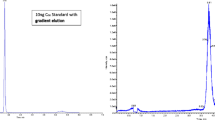Abstract
We have developed and validated in-house a liquid chromatography and mass spectrometry (LC–MS–MS) method for determination of N-nitrosodiethanolamine (NDELA) in cosmetics. The sample is diluted with water and then a C18 clean-up is performed. The average recovery of NDELA is 88.3%, range 48.3–112.7%, and the limit of detection is 22.8 μg kg−1. The repeatability is 7.6%, and the intermediate precision is 8.7%. Surveys were carried out in the Netherlands in September and October 2002 to determine the quantities of NDELA in cosmetics marketed in the Netherlands. The LC–MS–MS method was used to determine the NDELA content of 140 cosmetic products including shower gels, hair oils, shampoos and conditioners, cream and foam baths, mud baths, scrubs, crème and other soaps, and body washes. NDELA at levels ranging from 23 to 992 μg kg−1 was found in 35 cosmetic products.

Similar content being viewed by others
References
Report on Carcinogens (2002) U.S. Department of Health and Human Services, 10th edn. Public Health Service, National Toxicology Program
Tricker AR (1997) N-nitroso compounds and man: sources of exposure, endogenous formation and occurrence in body fluids. Eur J Cancer Prev 6:226–268
Krul CAM, Zeilmaker MJ, Schothorst RC, Havenaar R (2004) Intragastric formation and modulation of N-nitrosodimethylamine in a dynamic in vitro gastrointestinal model under human physiological conditions. Food Chem Toxicol 42:51–63
Ellen G (1997) Exposure to performed N-Nitroso compounds. In: Eisenbrand G, Bozler G, Nicolai HV (eds) The significance of N-nitrosation of Drugs. Gustav Fischer Verlag, Stuttgart, pp 19–46
Ellen G, Egmond E, van Loon JW, Sahertian ET, Tolsma K (1990) Dietary intakes of some essential and non-essential trace elements, nitrate, nitrite and N-nitrosamines by Dutch adults: estimated via a 24-hour duplicate portion study. Food Addit Contam 7:207–221
Stephany RW, Schuller PL (1980) Daily dietary intakes of nitrate, nitrite and volatile N-nitrosamines in The Netherlands using the duplicate portion sampling technique. Oncology 37:203–210
Havery DC, Chou HJ (1994) N-Nitrosamines in cosmetic products. Cosmetics Toiletries 109:53–62
Commission Directive 92/86/EEC (1992) Off J Eur Comm L325:18–22
Schothorst RC, Stephany RW (2001) Occurrence of N-nitrosodiethanolamine (NDELA) in cosmetics from the Dutch market. Int J Cosmetic Sci 23:109–114
Verhoef A, Schouten A (2002) Analysis of NDELA in rinse-off cosmetic products. TNO report V4685, Zeist
Commission decision of 12 August 2002 implementing council directive 96/23/ec concerning the performance of analytical methods and the interpretation of results—2002/657/ec (2002) Off J Eur Comm L221:8–36
Matyska MT, Pesek JJ, Yang L (2000) Screening method for determining the presence of N-nitrosodiethanolamine in cosmetics by open-tubular capillary electrochromatography. J Chromatogr A 887:487–503
Billedeau SM, Heinze TM, Wilkes JG, Thompson HC Jr (1994) Application of the particle beam interface to high-performance liquid chromatography-thermal energy analysis and electron impact mass spectrometry for the detection of non-volatile N-nitrosamines. J Chromatogr A 688:55–65
Meyer TA, Powell JB (1991) Quantification of the nitrosamine 2-ethylhexyl-4-(N-methyl-N-nitrosamino) benzoate (NPABAO) in sunscreen products. J Assoc Off Anal Chem 74:766–771
Acknowledgements
This study, within RIVM Project 310303 Nitrosoverbindingen in voeding en gebruiksartikelen, was done on behalf of, and for the account of the Food and Consumer Product Safety Authority, the Inspectorate for Health Protection and Veterinary Public Health, The Netherlands. The method described is currently under discussion for standardization in ISO TC 217 (cosmetics) wg 3 (nitrosamines).
Author information
Authors and Affiliations
Corresponding author
Rights and permissions
About this article
Cite this article
Schothorst, R.C., Somers, H.H.J. Determination of N-nitrosodiethanolamine in cosmetic products by LC–MS–MS. Anal Bioanal Chem 381, 681–685 (2005). https://doi.org/10.1007/s00216-004-2914-5
Received:
Revised:
Accepted:
Published:
Issue Date:
DOI: https://doi.org/10.1007/s00216-004-2914-5




